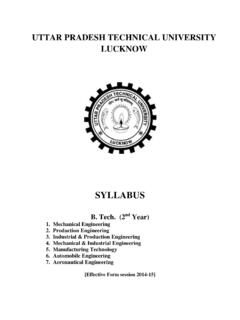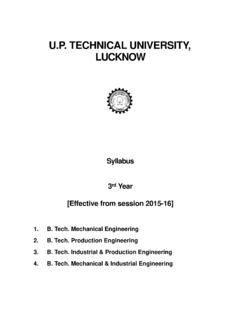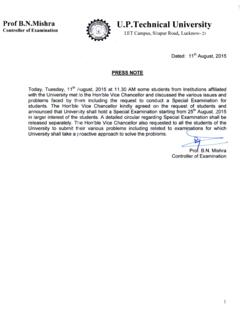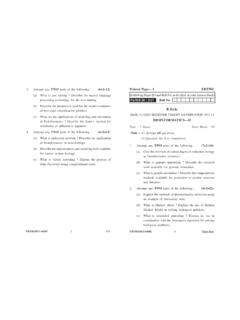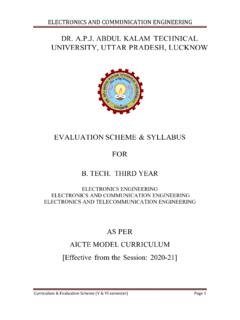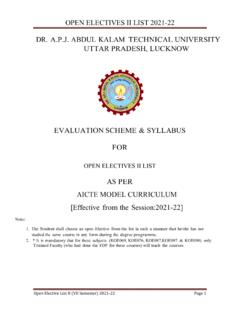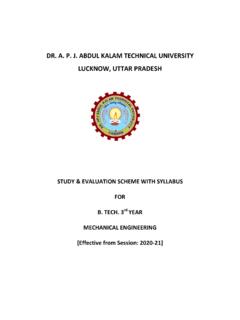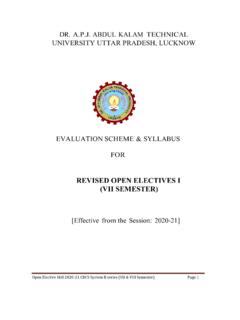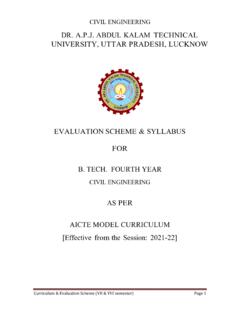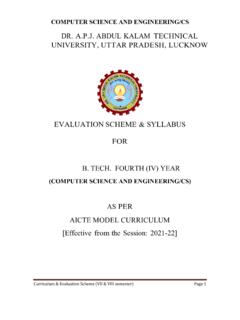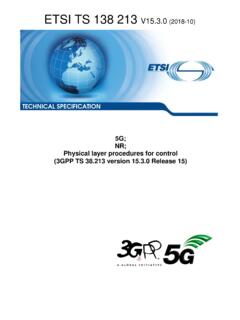Transcription of EVALUATION S CHEME & SYLLABUS FOR B. TECH. FOURTH …
1 ELECTR. RONICS AND. A COM. MMUNICA. ATION EN. NGINEER. RING. DR. R. ABDU. UL KAL. LAM TECHN. T NICAL. UNIV. VERSITTY, UTT TAR PR. RADES. SH, LUC. CKNOWW. EVA. ALUAT. TION SC. CHEME . E & SYL. LLABU. US. FOR. B. TECH. T F. FOURT. TH YEAR. R. ELE. ECTRONIICS ENGIN. NEERING. G. ELECT. TRONICS AND COMMMUNICA ATION EN. NGINEER. RING. E. ELECTRO. ONICS AN. ND TELEC. COMMUNICATION N ENGINEE. ERING. AS PER. AICTE. E MODE. EL CUR. RRICUL. LUM. [E. Effectivee from the t Sesssion: 20. 021-22]. Curricculum & Evalluation Schem me (VII & VIIII semester) Pagee 1. ELECTRONICS AND COMMUNICATION ENGINEERING.
2 VII Semester Electronics and Communication Engineering S. Course Code Course Title Periods EVALUATION Scheme End Total Credits No. Semester L T P CT TA Total PS TE PE. # #. 1. KHU701/KHU702 HSMC 1 /HSMC 2. 3 0 0 30 20 50 100 150 3. 2. KEC-071-074 Department Elective IV. 3 0 0 30 20 50 100 150 3. 3. KEC-075-076 Department Elective V. 3 0 0 30 20 50 100 150 3. 4. Open Elective-II. 3 0 0 30 20 50 100 150 3. 5. KEC-751X Lab for Department Elective - 0 0 2 25 25 50 1. 6. Mini Project or Internship KEC-752 0 0 2 50 50 1. Assessment**. 7. KEC-753 Project I. 0 0 8 150 150 4.
3 MOOCs (Essential for Hons. Degree). Total 850 18. Course Code Course Title Department Elective-I. KEC-071 Digital Image Processing KEC-072 VLSI Design KEC-073 Optical Network KEC-074 Microwave & Radar Engineering Department Elective-II. KEC-075 Information Theory & coding KEC-076 Wireless & Mobile Communication KEC-077 Micro & Smart Systems KEC-078 Speech Processing Course Code **Elective Lab KEC751A Digital Image Processing Lab KEC751B VLSI Design Lab KEC751C Optical System and Networking Lab KEC751D Microwave & Radar Engineering Lab **Students will opt one subject from the list of Department Elective-IV with its corresponding lab.
4 If someone has opted Digital Image Processing (KEC071) from Department Elective-IV then it will be mandatory to opt the DIP Lab (KEC751A). Curriculum & EVALUATION Scheme (VII & VIII semester) Page 2. ELECTRONICS AND COMMUNICATION ENGINEERING. VIII Semester Electronics and Communication Engineering S. Course Course Title Periods EVALUATION Scheme End Total Credits No. Code Semeste L T P CT TA Total PS TE PE. # #. 1. KHU801/K HSMC -1 /HSMC-2. HU802 3 0 0 30 20 50 100 150 3. 2. Open Elective III 3 0 0 30 20 50 100 150 3. 3. Open Elective IV 3 0 0 30 20 50 100 150 3.
5 4. KEC-851 Project II 0 0 18 100 300 400 9. MOOCs (Essential for Hons. Total 850 18. Curriculum & EVALUATION Scheme (VII & VIII semester) Page 3. ELECTRONICS AND COMMUNICATION ENGINEERING. 4rd Year VII Semester SYLLABUS Curriculum & EVALUATION Scheme (VII & VIII semester) Page 4. ELECTRONICS AND COMMUNICATION ENGINEERING. KEC-071 Digital Image Processing 3L:0T:0P 3 Credits Unit Topics Lectures I Introduction: Overview of Image Processing, Application area of image 8. processing, Digital Image Representation, Types of images, Digital Image Processing Operations, Fundamental steps in DIP, Overview of Digital Image Systems, Physical Aspect of Image Acquisition, biological Aspect of Image Acquisition, sampling & quantization, Digital Halftone Process, Image storage and File formats.)
6 II Image Enhancement: Need for image enhancement, Image enhancement 8. operations, Image enhancement in spatial domain, histogram based techniques, Spatial Filtering concepts, Image smoothing and sharpening spatial and frequency domain filters, homomorphic filtering. Image Restoration: Introduction to degradation, types of Image degradations, image degradation models, noise modeling, estimation of degradation functions, Image restoration in presence of noise only, periodic noise and band pass and band reject filtering, difference between enhancement & restoration, Image restoration techniques.
7 III Image Transforms: Need for image transforms, Properties of Fourier transform, 8. Discrete cosine transform, Discrete sine transform, Hadamard transform, Haar transform, Slant transform, SVD and KL transforms. IV Image Compression: Image compression model, type of redundancy, 8. compression algorithms and its types, lossless compression algorithms, lossy compression algorithms, image and video compression standards. V Image Segmentation: Introduction, Detection of Discontinuities, Edge 8. Detection, Hough Transforms and Shape Detection, corner detection, Principle of thresholding, Principle of region - growing.
8 Text Book: 1. Rafael C. Gonzalez Richard E woods Steven L. Eddins, Digital Image Processing'', Mc Graw Hill, 3rd Edition, 2008. 2. Anil K Jain, Fundamentals of Digital Image Processing , Prentice-Hall of India Pvt. Ltd, 1989. Reference Books: 1. Jayaraman, Digital Image Processing , Tata Mc Graw hill Education, India, 2009. 2. S. Sridhar, Digital Image Processing , OXFORD University Press, Second Edition, 2011. Course Outcomes: At the end of this course students will demonstrate the ability to: 1. Describe the concept and need for image processing. 2. Implement the various techniques for image enhancement and restoration both in spatial and frequency domains.
9 3. Interpret the various types of image transforms and their properties. 4. Distinguish between lossless and lossy image compression algorithms and examine their performances in spatial and frequency domains. 5. Examine the various image segmentation techniques. Curriculum & EVALUATION Scheme (VII & VIII semester) Page 5. ELECTRONICS AND COMMUNICATION ENGINEERING. KEC-072 VLSI Design 3L:0T:0P 3 Credits Unit Topics Lectures I Introduction: VLSI Design flow, general design methodologies; critical path 8. and worst case timing analysis, overview of design hierarchy, layers of abstraction, integration density and Moore's law, VLSI design styles, packaging, CMOS Logic, Propagation Delay definitions, sheet resistance.
10 II Interconnect Parameters: Resistance, Inductance, and Capacitance, skin 8. effect and its influence , lumped RC Model, the distributed RC Model, transient Response, RC delay model, Linear Delay Model, Logical Effort of Paths, Scaling. III Dynamic CMOS design: steady-state behavior of dynamic gate circuits, 8. noise considerations in dynamic design, charge sharing, cascading dynamic gates, domino logic, np-CMOS logic, problems in single-phase clocking, two- phase non-overlapping clocking scheme, Sequential CMOS Logic Circuits, Layout design. IV Semiconductor Memories: Dynamic Random Access Memories (DRAM), 8.
